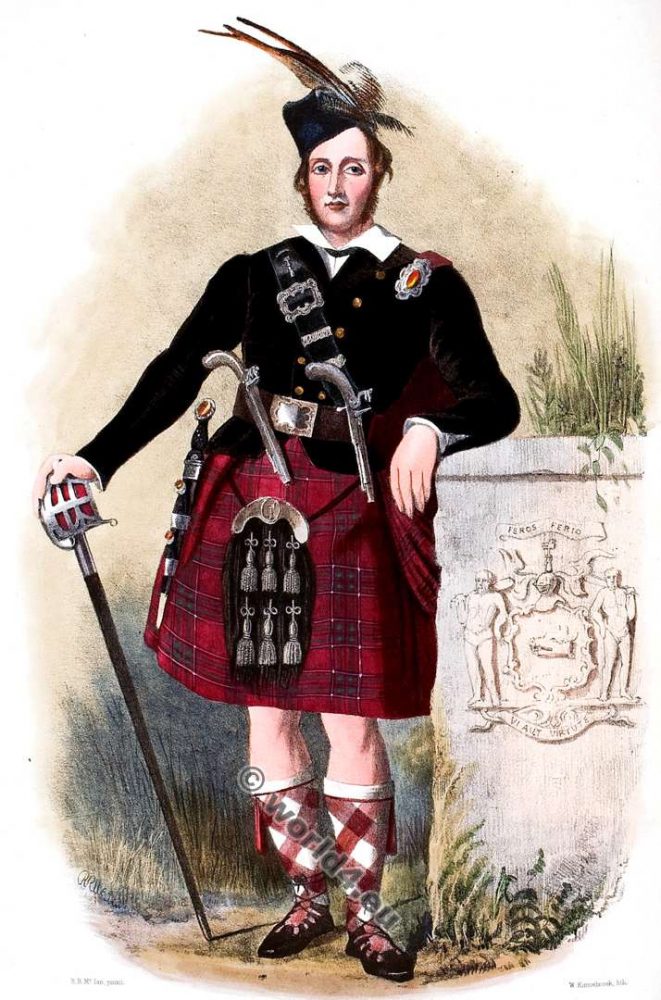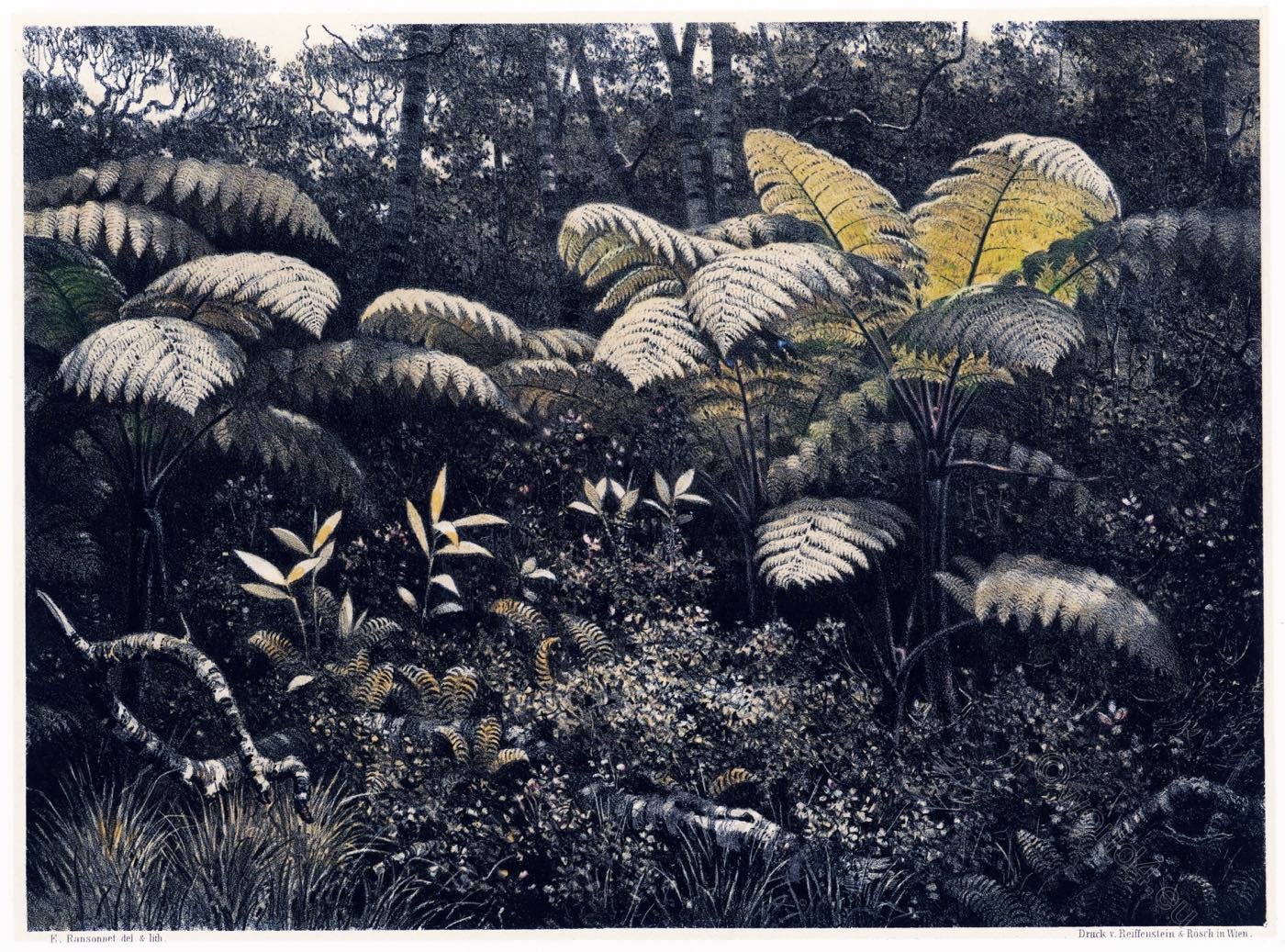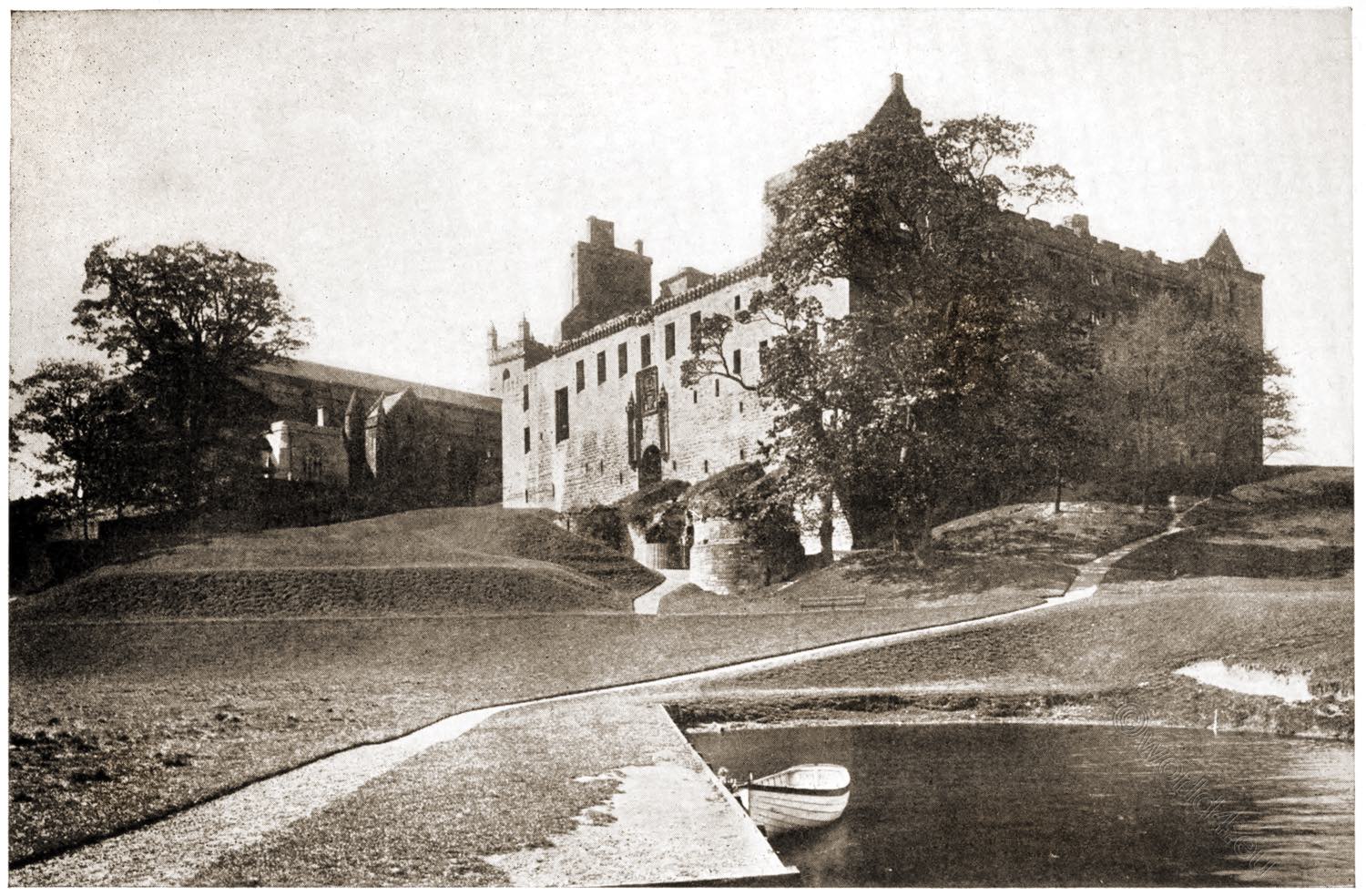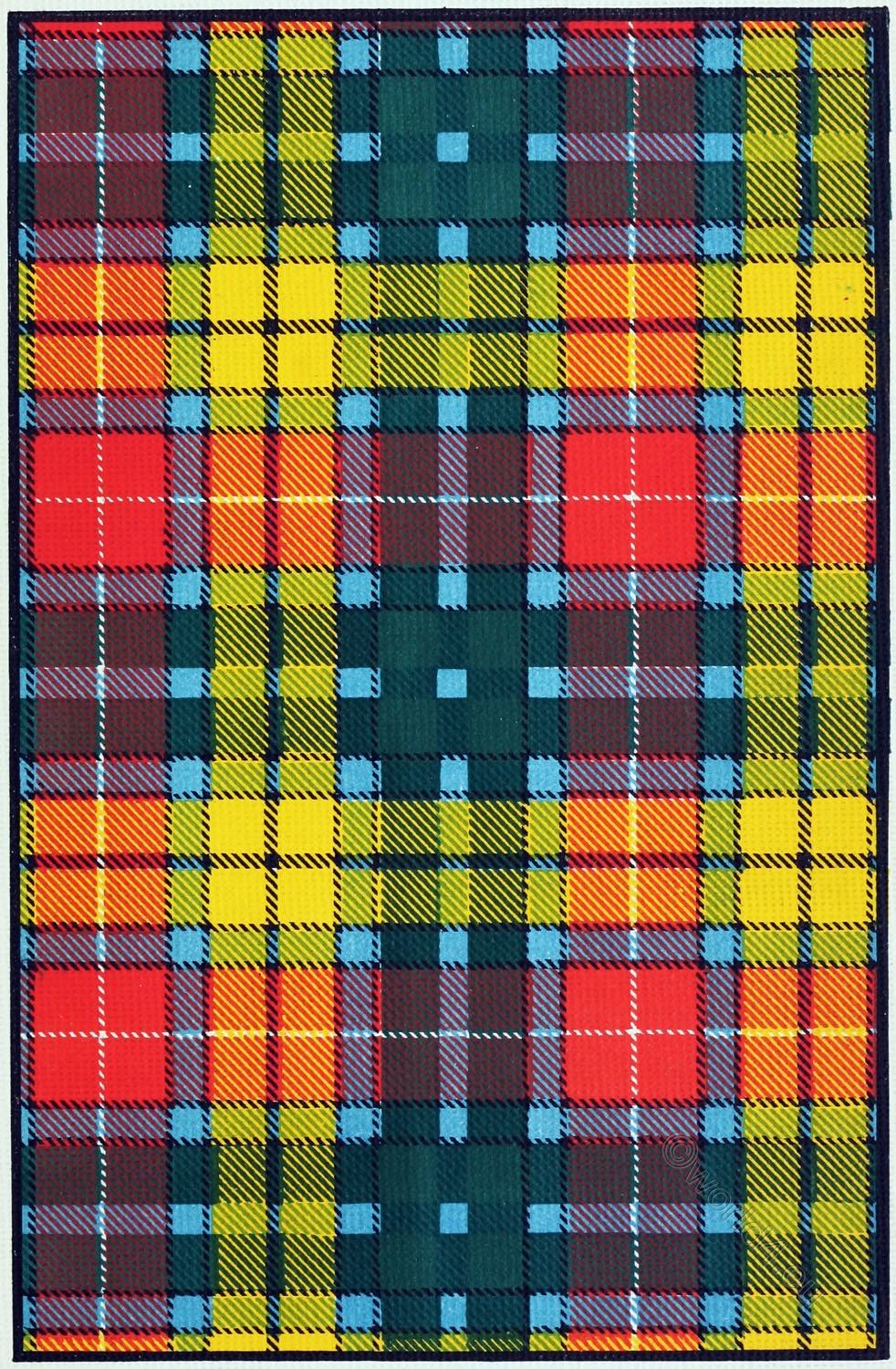CLANN SIOSAL, OR THE CHISHOLMS.
The Clans of the Scottish Highlands.
THE claim of this clan to a Celtic origin has been very confidently opposed by some writers; but their opinions, formed all different grounds, arise in consequence of a confusion of names, an insufficient knowledge of the Gaëlic language, and a want of due consideration of Highland and Lowland usages. Chisholm is the Saxon name of a property on the border of Scotland, and the proprietor is designated from his estate, but no such name exists in the Highlands. The vernacular appellation is Siosal, and the translation of that word is one of the numerous similar corruptions introduced by the capricious ignorance of chroniclers and fanciful heralds.
An t-Siosal, The Chisholm
Chisholm of Chisholm is very improperly substituted for An t-Siosal, The Chisholm.
Again-those who came to understand the original appellation found, by a fertility of imagination, that the race of Siosal descended from the English Cecils; but the ancestors of that family were Cambrian knights, who bore the appropriate name of Sytsylt and Seisylt, long after the Chisholms appear in the pages of national history; and the coat armour, on which so many fortify their belief of family connexion, is entirely dissimilar.
Harald, or Guthred, Thane of Caithness, flourished in the latter part of the twelfth century. Sir Robert Gordon gives him the surname of Chisholm; and the probability is, that it was the general name of his followers. He married the daughter of Madach, Earl of Athol, and became one of the most powerful chiefs in the north, where he created continued disturbances during the reign of William the Lion, by whom he was at last defeated and put to death, his lands being divided between Freskin, ancestor of the Earls of Sutherland, and Ma’nus, or Magnus, son of Gillibreid, Earl of Angus.(History of the Earls of Sutherland, fol. Lord Hailes. Annals.)
It seems that, from the rigorous prosecution to which the followers of Harald were subjected, they were compelled, as was the case with several other clans in troublous times, to seek for new possessions; and Strathglas offered an eligible position for a high-spirited clan maintaining their independence.
These proceedings occurred about 1220; but we do not find other notice of the Chisholms until 1334, when the clan was of such importance as to induce Sir Robert Lauder, of Quarrel Wood, who was Constable of Urquhart Castle, on the bank of Lochness, to seek its alliance by giving his daughter and heiress in marriage to the Chief. There are, indeed, the signatures of Richard de Chesehelm and John de Cheshome, in Roxburgh and Berwick shires, attached to the deed called Ragman’s Roll, 1296;† (Prynn) it but none of the Siosailich submitted to this degradation or betraying their country’s independence. Robert, the son of this marriage, acquired Quarrel Wood in right of his mother, and succeeded to the important trust of the keeping of Castle Urquhart. He obtained the honour of knighthood, and was taken prisoner, with King David II., at the unfortunate battle of Neville’s Cross, 1346.
He lived long after his release; and his piety is attested by a well-preserved deed, dated Inverness, the feast of the Epiphany of the Holy Cross, 1362, in which he grants, for the salvation of his own soul, and those of his ancestors and successors, six acres of arable land lying within the lands of the old castle of Inverness. The piece of ground thus bestowed is still, in part, the property of the Kirk Session; and its proceeds being devoted to relieve the poor, it was called Tir na bochd, now, corruptly, Diribught, “the poor’s lands.” Many charters and exchanges of property between the different chiefs, the Scottish kings, and nobility, took place, which shows that their possessions were very extensive.• Family History. 4to. MS.
John de Chesehelm
They occasionally got into misunderstandings with the bishops and chapter of Moray, respecting their lands in that county. In 1369 these clergy made complaint that Robert, Lord of Quarrel Wood, had “wrongously intromitted” with some of their property; and, in 1398, John de Chesehelm was charged to give up the lands of Kinmlylies, which were the church’s patrimony.
The form of an act of homage, 1368, for certain lands, is preserved, which is somewhat curious:-” In Camera domini Alexandri Dei gratia Episcopi Moraviensis apud struy presente tota multitudine Canonicorum et Capellanorum et aliorum, ad prandium ibi invitatorum. Alexander de Chisholme fecit homagium junctis manibus et discooperta capite, pro eisdem terris,” &e. About this time, Uilan, or Wyland, hodie William, “venerabilis vir et dominus,” was treasurer of Moray, and appears to have been a very active official. († Registrum Moraviensis).
Alexander Sutherland, Baron of Duffus
John, who was chief at the end of the fourteenth century, had an only child, Morella, who married Alexander Sutherland, Baron of Duffus, and she carried away so much of the property, that the male heir was greatly reduced, having little more than the “country” of Strathglas. From this marriage the house of Duffus carry the addition of the boar’s head in their armorial coat.
An indenture for the settlement of the respective lands was entered into, in 1403, between Margaret de la Aird, widow of Alexander, late chief, then designed from the place of his residence, “of Comar,” his successor, Thomas, and William Lord Fentoun, heirs portioners, by which we find the property lay, not only in Inverness and Moray shires, but in the counties of Perth, Forfar, and Aberdeen.
Battle of Killicrankie 1689
In 1513, we find Uilan of Comar assisted by Alastair Mac Ranald of Glengarry, storming the castle of Urquhart. In 1587, the chiefs, on whose lands resided broken men, were called upon to give security for their peaceable behaviour, among whom appears “Cheisholme of Cummer.”
After the battle of Killicrankie, 1689, Erchless Castle was garrisoned for King James, and it required considerable exertion, on the part of General Livingstone, to dislodge the Highlanders, and prevent them from regaining possession of it, having besieged it with a large force. Ruarai’, or Roderic Mac Ian, had signed the address of 102 chiefs and heads of houses to George I., expressive of their loyalty, but no notice being taken of it, he engaged very actively in the rising under the Earl of Mar, 1715, Chisholm of Cnocfin, an aged veteran, heading the clan at the field of Dunblane, in requital for which his estates were forfeited and sold.
In 1727 he procured, with several other chiefs, a pardon under the privy seal; and Mac Kenzie of Allangrange, who then possessed the lands, “disponed” them the same year to Chisholm of Mucherach, who again conveyed them to Roderic’s eldest son, and entailed them on his heirs male.
This chief, so devoted to the family of Stewart, joined his fortune with that of Prince Charles, 1745, and Colin, his youngest son, was appointed colonel of the Clan Battalion. Alexander, who succeeded to the family honours and estates in 1785, left an only child, Mary, married, to James Gooden, Esq., London; and dying in 1793, the chiefship and property, agreeably to clan law, and by the deed of entail, devolved on his youngest brother, William, who married Elizabeth, eldest daughter of Duncan Mac Donell, Esq” of Glengarry, and left two sons and a daughter. On his death, 1817, he was succeeded by the elder son, Alexander William, late member of parliament for Invernesshire, who was doomed to fill a premature grave, September, 1838, and of whose amiable life an interesting memoir has recently appeared.
The succession now rests on his brother, Duncan Mac Donnell (Gaëlice, Doncha’ Mac Dhonuill), who inherits, in an eminent degree, the patriotic characteristics of a Highland chief; while he actively promotes all objects in which his countrymen are interested, he cordially supports those institutions beneficial to society in general.
The Chisholms of Cromlics
The Chisholms of Cromlics, in Perthshire, were a distinguished branch of this clan, and were remarkable for giving three bishops of Dunblane in succession, who were most strenuous opposers of the Reformation, which involved them in continued trouble, and led to the loss of their patrimony, and the expatriation of William, who became Bishop of Vaison. By the marriage of Jane, only daughter of Sir James Chisholm of Cromlics, to James, second son of David Lord Drummond, the lands were carried to the family of Viscount Strathallan, and gave him the second title.
The ARMORIAL BEARINGS
The ARMORIAL BEARINGS of the Chisholm are on a shield gules, a boar’s head couped, or. Crest, a dexter hand couped at the wrist, holding a dagger, proper, on which is transfixed a boar’s head couped, of the second. Supporters, two savages wreathed about the head and loins, and bearing knotted clubs, proper. Mottoes: above the escutcheon, “Feros ferio:” -underneath, “Vi aut virtute.”
The SUAICHEANTAS
The SUAICHEANTAS, or Badge, is Rainneach, Filix, Fern. The PIOBAIREACHD, or Gathering, is Failte Siosalaich Sthrathglas, the Salute or Welcome to the chiefs, a fine piece of pipe-music, composed in praise of their noted hospitality. Erchless Castle, the family seat, is an old baronial mansion, situated in a picturesque locality in Strath-glas, or the Grey-valley. The burial-place was in the chancel of Beaulieu Priory, now in ruins; but there is no monument, except a mural slab erected in memory of Alexander, who died 1793, by his only daughter. The late chief was buried, by his own desire, on a verdant mount, surrounded by venerable trees, near the castle, where several of his remote ancestors likewise repose. The military force of this clan, in 1745, amounted to 200 men, but their “following” must have been formerly much greater.
Battle of Culloden 1746
After the disastrous battle of Culloden, Prince Charles was obliged to trust his life to the honour of his devoted followers, and three poor individuals of this clan concealed and supported him in a cave, and safely conveyed him to the coast of Arisaig, resisting the temptation of £30,000 offered for his apprehension. Hugh Chisholm, otherwise Mac Lea, one of these faithful Highlanders, having shaken hands with the Prince when parting, made a vow, which he religiously observed, that his right hand should never be offered to another.
One of the chiefs having carried off a daughter of Lord Lovat, placed her for safety in an islet in Loch Bruiach, where she was soon discovered by the Frasers, who had speedily mustered for the rescue. A severe conflict ensued, during which the young lady was accidentally slain by her own brother! A plaintive Gaëlic song records the sad calamity, and numerous tumuli mark the graves of those who fell.
The Court-dress
The figure is represented in the attire in which the chief usually appears when present at festivals and national meetings. This costume is the court-dress of a Highlander; and the Chisholms’ plain tartan is as proud a passport to the presence of royalty as the splendid uniform of the British guards. The black velvet jacket contrasts well with the red-coloured kilt, and, by wearing the imitation of the old belted plaid, the breast is left free, and neither ornaments nor arms are bidden. The pistols are remarkable for size, but they are painted from a genuine old family pair. The brogs are of a pattern frequently worn by gentlemen.
Source: The clans of the Scottish Highlands… by James Logan. London: Ackermann, 1845-1847.
THE CLAN CHISHOLM. The Scottish clans and their tartans.
Clan Pipe Music: Lament “Cum ha do dh’ Uilleam Siseal” (“Lament for William Chisholm”).
Badge: Fearna (Alder); or Raineach (Fern).
The chieftain of this tribe is not of original Celtic descent, though, curious to say, the whole tribe are the descendants of a pure Gaelic race, and their stronghold was Erchless Castle in Strathglass, amid superb mountain scenery. It stands a little below the confluence of the Glass and the Farrar, “and still belongs,” says Miss Sinclair, “to the descendants of that old chief, who said there were but three persons in the world entitled to be called ‘The’ – The King, The Pope, and The Chisholm. The place is beauty personified. The castle is a venerable whitewashed old tower, so entirely surrounded by a wreath of hills that the glen seems scooped out on purpose to hold the house and park.”
In the time of David II., Robert Chisholm, knight, witnessed a crown charter at Perth in the thirty-ninth year of the King’s reign, 1369; and there is a charter, by Robert II., to the Earl of Buchan of Lochletter, Inchbrennys, etc., Invernessshire, by the resignation of Robert Cheshelm (sic); and under the Regency of the Duke of Albany there was an indenture between Margaret of Eccles and Thomas of Chisholm, her son and heir, dividing between them certain lands of which they were heirs-portioners, in Forfarshire, Perthshire, Inverness, and Aberdeenshire. It is dated at Kinrossie, 25th April 1403 (Robertson’s “Index”). The name occurs very seldom in Scottish history.
Three of the clan were in succession Bishops of Dunblane. In I486, Bishop James Chisholm, chaplain to James III., resigned the See in favor of his brother William in 1527, a most irreverent prelate, who wasted the revenues of it on his natural children, particularly Sir James Chisholm of Cromlix. His nephew, William Chisholm, became Bishop of Dunblane in 1564, after being coadjutor in 1561. He was much employed in political affairs at foreign courts, and ultimately withdrew to France, where he was made Bishop of Vaison (Beatson’s “Index.”)
In 1579, John Chisholm was Comptroller of the Artillery, and John Acheson became caution for him, that “he would behave himself as a good and loyal subject, under pain of £1000 (Reg. of Council).
James Chisholm of Cromlix (son of the Bishop) was Master of the Household to James VI., though in 1429, Colin, Earl of Argyll, was appointed Master heritably, a dignity reserved at the Union.
In 1581, Walter Chistiolm of that Ilk is referred to in the “violations of the assurances of peace between the Scotts and Elliots” (Ibid).
In the “Roll of the Landislordis and Baillies,” under date 15S7, printed in the “Transactions of the Iona Club,” the name of Chisholm of Comer appears. A note to the “Geography of the Clans” therein states that “Alexander Chisholm of Strathglass was alive in 1578, “and that” John Chisholm of Comer is mentioned, anno 1613.”
In 1598 the name of William, the ex-Bishop of Dunblane, appears in history again, when he must have been in extreme old age.
“It would seem that in 1608 James, Lord Balmerino, the Scottish Secretary of State was challenged in England, says Balfour, “concerning some letter written by him in 1598, by the king’s orders, to Pope Clement VIII., to obtain a cardinal’s hat for Chisholm, a Scotts man, then Bishop of Weasone, in France, brother to the Laird of Crouneriggas, in Perthshire, in which letter he styles the Pope ‘Beatissime Pater,’ and other such phrases, which almost wronged the king’s honor” (“Annales”).
In the Report on the Clans, furnished to Government by Duncan Forbes, he enters the surname thus: “Chisholms. Their chief is Chisholm of Strathglass, in Gaelic called ‘Chisallich.’ His lands are held of the Crown, and he can bring out 200 men.”
In 1777, Alexander Chisholm of Chisholm entailed his estates in Inverness and Ross-shire; and to_this day the picturesque old fortalice of Erchless is still in existence.
Alexander Chisholm’s great-grandson, Roderick, died in 1887, the last “Chisholm.”
The clans of the Scottish Highlands: Illustrated by appropriate figures, displaying their dress, arms, tartans, armorial insignia, and social occupations, from original sketches by R.R. McIan, esq.: With accompanying description and historical memoranda of character, mode of life by James Logan. London: Ackermann, 1845-1847.
Source: The Scottish clans and their tartans: with notes. LIBRARY EDITION. Publisher: Edinburgh: W. & A.K. Johnston, ca. 1910.
Related: The clans of the Scottish Highlands
Source:
- The clans of the Scottish Highlands: Illustrated by appropriate figures, displaying their dress, arms, tartans, armorial insignia, and social occupations, from original sketches by R.R. McIan, esq.: With accompanying description and historical memoranda of character, mode of life by James Logan. London: Ackermann, 1845-1847.
- The Scottish clans and their tartans: with notes. LIBRARY EDITION. Publisher: Edinburgh: W. & A.K. Johnston, ca. 1910.
- History of the Chisholms, with genealogies of the principal families of the name (1891) Author: Mackenzie, Alexander, 1838-1898 Publisher: Inverness : A. & W. Mackenzie
Related
Discover more from World4 Costume Culture History
Subscribe to get the latest posts sent to your email.








